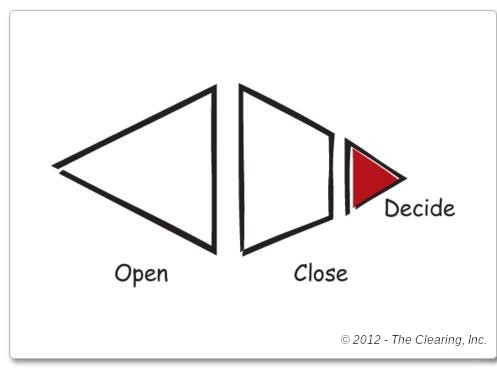Groups move from OPEN discussion of alternatives to CLOSING conversations where the decision criteria reveal themselves. Finally, one person DECIDES the outcome.
Understanding how groups naturally work is essential to be an effective group leader or participant. Groups have a time initially when they tolerate the generation of ideas (OPEN). This process, once called “brainstorming,” now often includes “crowd sourcing.” Eventually, the group becomes less tolerant of new ideas and begins the process of convergence (CLOSE). Resistance turns into disregard for new ideas, while the group focuses its attention on only a few. Finally, the group enters the third phase of the process when a choice is made (DECIDE). It’s critical to recognize that the DECIDE process is distinct from the CLOSE process – this insight is essential.
OPEN
The OPEN phase is the most fun and the easiest to lead and facilitate. As long as a leader suspends judgment and makes it safe for people to offer their opinions and ideas, the primary value of the OPEN phase will be realized. Teams will generate fresh ideas, they’ll build exciting concepts, and mash everything together to create innovative approaches.
CLOSE
Groups tend to enter the CLOSE phase when they run out of ideas, patience, or time. The stakes are higher than in the OPEN phase and being right becomes more important than being provocative. The CLOSE phase is marked by a distinct tone of judgment; certain ideas are deemed worthy and others are cast aside. Leaders must listen closely, because this is where the group begins to reveal its “decision criteria.”
DECIDE
Like genocide, pesticide, and suicide, DECIDE is about death (“cide”). The DECIDE phase is the final act of killing off alternatives and leaving one option alive. Regardless of how many people are involved, groups don’t make decisions. Real decision-making comes down to one person who chooses for the group.
The vote is the lone exception to this rule that one person ultimately DECIDES. When collaboration and CONSENSUS fail and leadership can’t be trusted, people surrender their opinions and allow math to DECIDE.
IN ACTION
As the conversation turns towards the CLOSE, listen for the group’s decision criteria to emerge, typically following the word “because,” as in, “I don’t think this is a good idea because it costs too much.” The person voicing this statement makes it clear that he or she perceives cost as a major criterion in making a decision. Mastering the skill of distinguishing decision criteria allows effective leaders to make or support effective decisions.
SO WHAT?
In any group, one person has the power and the expectation of the others to DECIDE for all, once sufficient time and attention has been given to the OPEN and CLOSE phases. Understand this process and you can use it to drive effective decision-making.
Special thanks to Kai Dozier of CEI-Star, for his invaluable insights in developing this PRIME.

